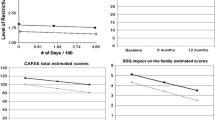Abstract
Systems of care for children with serious emotional disturbance and their families have generally lacked intensive community-based programs. We describe three types of newly established community-based programs in New York State and present a general evaluation plan for determining which programs work for various children and their families. The three community-based programs are Intensive Case Management, Family-Based Treatment, and Family-Centered Intensive Case Management. Process and outcome evaluations are being conducted for each of these programs. These evaluations make use of common intake and termination instruments, based on a minimum data set, standardized assessment instruments, and a common logic model, thus facilitating the comparison of findings across evaluations.
Similar content being viewed by others
References
Achenbach, T. M., & Edelbrock, C. (1983).Manual for the Child Behavior Checklist and Revised Child Behavior Profile. Burlington, VT: University of Vermont Department of Child Psychiatry.
American Psychiatric Association. (1987).Diagnostic and statistical manual of mental disorders (3rd ed.—rev. ed.). Washington, DC: American Psychiatric Association.
Armstrong, M. I., Surles, R., & Evans, M. E. (1991). Developing a state policy framework for children with serious emotional disturbances.Journal of Mental Health Administration.
Blumenthal, K., & Weinberg, A. (Eds.). (1984).Establishing parent involvement in foster care agencies. New York: Child Welfare League of America, Inc.
Brownstone, D. (Ed.). (1989).Parents together: A manual for leaders of support groups for parents of children experiencing emotional and behavioral disorders. Albany, NY: New York State Office of Mental Health.
Bryant, B. (1981). Special foster care: A history and rationale.Journal of Clinical Child Psychology, 10 8–20.
Craig, T., Hussey, P., Kaye, D., Kemsey, J., McCreath, J., Tremblay, J., & Vedus, M. (1987). Family support programs in a regional mental health system.Hospital and Community Psychiatry, 38 458–459.
Donner, R. (1988).Rest-a-Bit: Respite care training project. Topeka, KS: Families Together.
Dougherty, D., Saxe, L. M., Cross, T., & Silverman, N. (1987). Children's mental health problems and services: A report by the Office of Technology Assessment. Durham, NC: Duke University Press.
Education of the Handicapped Act (1975), P.L. 94–142, as amended 20 U.S.C. 1401 et seq.
Friedman, R. M. (1988).The role of therapeutic foster care in an overall system of care: Issues in service delivery and program evaluation. Tampa, FL: Research and Training Center for Children's Mental Health.
Friedman, R. M., & Street, S. (1985). Admission and discharge criteria for children's mental health services: A review of the issues and options.Journal of Clinical Child Psychology, 14 229–235.
Friesen, B., Griesbach, J., Jacobs, J., Katz-Leavy, J., & Olson, D. (1988). Improving services for families.Children Today, 17 18–22.
Friesen, B., & Koroloff, N. (1990). Family-centered services: Implications for mental health administration and research.Journal of Mental Health Administration, 17 13–26.
Interagency Workgroup on Specialized Family Care. (November 1989).Specialized family care for children: An innovative alternative to congregate care. Albany, NY: New York State Council on Children and Families.
Knitzer, J. (1982).Unclaimed children. Washington, DC: Children's Defense Fund.
Leginski, W. A., Croze, C., Driggers, J., Dumpman, S., Geertsen, D., Kamis-Gould, E., Namerow, M. J., Patton, R. E., Wilson, N. Z., & Wurster, C. R. (1989).Data standards for mental health decision support systems. Rockville, MD: National Institute of Mental Health (ADM 85-1589).
Maluccio, A. N., & Sinanoglu, P. A. (Eds.). (1981).The challenge of partnership: Working with parents of children in foster care. New York: Child Welfare League of America.
New York State Office of Mental Health, Mental Health Planning Advisory Committee, Children and Families Task Force. (1989).Background paper (draft). Albany, NY: New York State Office of Mental Health.
Petr, C. G., & Spano, R. N. (1990). Evolution of social services for children with emotional disorders.Social Work, 35 228–234.
Shern, D. L., Evans, M. E., & Veysey, B. M. (1992). Human resource, program and client correlates of mental health outcomes. In J. W. Jacobson, S. N. Burchard, & P. J. Carling (Eds.),Community living for people with psychiatric and developmental disabilities (pp. 263–283). Baltimore, MD: Johns Hopkins Press.
Snodgrass, R. (1986).Parent skills training curriculum. Staunton, VA: People Places.
Title V, The State Comprehensive Mental Health Plan Act of 1986, P.L. 99-660, as amended 42 U.S.C. 300 et seq.
Author information
Authors and Affiliations
Rights and permissions
About this article
Cite this article
Armstrong, M.I., Evans, M.E. Three intensive community-based programs for children and youth with serious emotional disturbance and their families. J Child Fam Stud 1, 61–74 (1992). https://doi.org/10.1007/BF01321342
Issue Date:
DOI: https://doi.org/10.1007/BF01321342




